It’s tough to be the opening act for two intriguing world premieres and Balanchine’s bulletproof Symphony in C. Jerome Robbins’ Opus 19/The Dreamer is not quite up to the task. The Prokofiev score may be an intoxicating ride for the solo violin, but Robbins’ choreography is a much tamer affair.
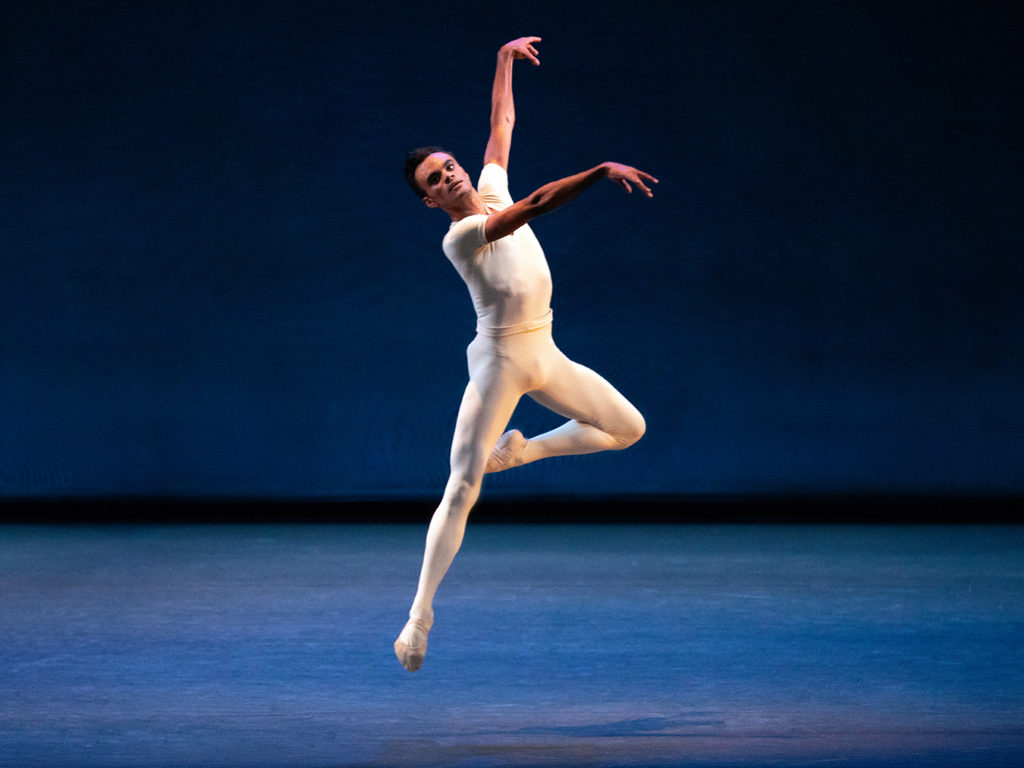
Taylor Stanley in Jerome Robbins’ OPUS 19/THE DREAMER (Photo: Erin Baiano)
The ballet’s staying power likely stems from memories of Baryshnikov and McBride in the original cast, however on Oct. 2 at New York City Ballet the eloquent Taylor Stanley and spirited Lauren Lovette owned it. They made the most of a handful of witty interactions, and shot their legs like arrows into a twilight sky while twisting and flopping their torsos. Her jazzy hops on pointe were the bomb. The prancing corps, who were just a distraction in the early movements, wove a beguiling thicket around the Dreamer and his elusive muse in the later movements, sometimes ominous, at other times protective. Solo violinist Arturo Delmoni conjured up the dream/nightmare with ferocity.
Either of the two world premieres – Edwaard Liang’s elegant Lineage or Lauren Lovette’s The Shaded Line – would have made a snappier opener. Both are buttressed by tremendous scores. Composer Oliver Davis’ multi-hued composition, titled ‘Apollo,’ created an alluring backdrop to what Liang, who danced with City Ballet in the 90s, has described as his homage to Balanchine’s Georgian roots. Hints of Eastern European folk dance were indeed visible in footwork and gestures, and were meant to flavor the costumes by Anna Sui – created for the annual gala that pairs choreographers with prominent couturiers. Up close, the costumes may look handsome and rich in detail, but from the house the voluminous and shiny gold skirts obscured much of the women’s movements; the bibbed burgundy tops and burgundy men’s tights looked drab in comparison. The women removed their skirts about a third of the way through, notably for the pas de deux. But that only reinforced a tired trope of modern ballet in which barelegged women are partnered by fully clothed men. (We are long overdue for a new rule in ballet: if the women rip off their skirts, the men must relinquish their trousers. It’s only fair.)

New York City Ballet in Edwaard Liang’s LINEAGE (World Premiere), (Photo: Erin Baiano)
The only metaphor I could come up with to explain the glittering gold skirts was capitalism. As the music grew more bellicose and the women shed their skirts it looked like revolution might be in the offing. The pugnacious Roman Mejia was tasked with several explosive solos, very Russian in nature, that seemed to be a call to arms. This notion was further bolstered by a haunting duet for Maria Kowroski and Tyler Angle in which she seemed to be bidding him a reluctant farewell before his comrades-in-arms turned up. They parted the pair but at the eleventh hour, Angle whisked her into an overhead lift and carried her offstage. (Perhaps he was a conscientious objector.) He did return to deliver a brief bracing solo.
Liang’s imagination crested chiefly in the duets – one witty and acrobatic for Ashley Bouder and Peter Walker, another tender and serene for Sara Mearns and Russell Janzen. Mearns dialed down her usual dramatic intensity for this poetic duet marked by encircling arms and skimming lifts – both score and choreography matched in sweetness without the saccharin that often plagues duets in abstract ballets. This pas de deux was, for me, the highlight of the entire evening.
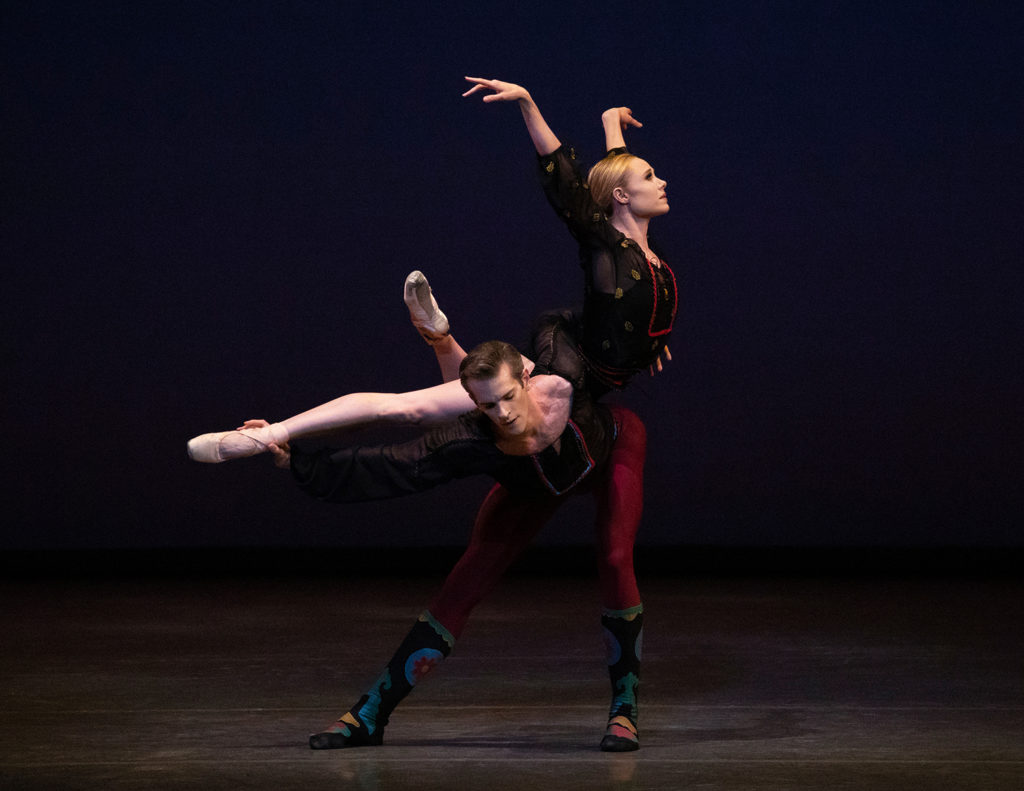
Sara Mearns and Russell Janzen in Edwaard Liang’s LINEAGE (World Premiere), (Photo: Erin Baiano)
Liang’s ensemble work tilted heavily to the formulaic but I’d be down to see this piece again, preferably with a costume rethink.
In contrast, Lovette’s choreography in The Shaded Line was most inventive in group settings but sometimes veered toward cliché in the solo work. Composer Tan Dun’s ‘Fire Ritual’ came charging out of the gate with extra complements of Western and Chinese percussion – spurred on by Kurt Nikkanen on solo violin – and didn’t let up. Costumes by Zac Posen made a strong point about the objectification of women: the ensemble men were conventionally clad in princely ballet garb, and both sexes sported the usual sparkly accessories, but the women’s tutus suggested Swan Lake gone wrong: cut out in front and shrunken in the back, they blatantly called attention to groins and derrières.

Georgina Pazcoguin flanked by, from left, Davide Riccardo, Mary Thomas MacKinnon, Gilbert Bolden, Unity Phelan and Jonathan Fahoury in Lauren Lovette’s THE SHADED LINE (World Premiere (Photo: Erin Baiano)
Costumes and choreography for the four central figures further signposted the struggle for acceptance by those who are othered. Mary Thomas McKinnon’s tutu was long and droopy, while Unity Phelan’s was pinned up in the back all the way to her shoulders. Taylor Stanley was a different kind of prince, with little sylphide-style wings on his back. Protagonist Georgina Pazcoguin would partner all three, defying conventions of ballet partnering. Her only concession to ballet tradition was a pair of pointe shoes, dyed black to match her black trousers, which she removed halfway through to dance barefoot. A buttoned-down shirt and cropped black wig completed her androgynous look.
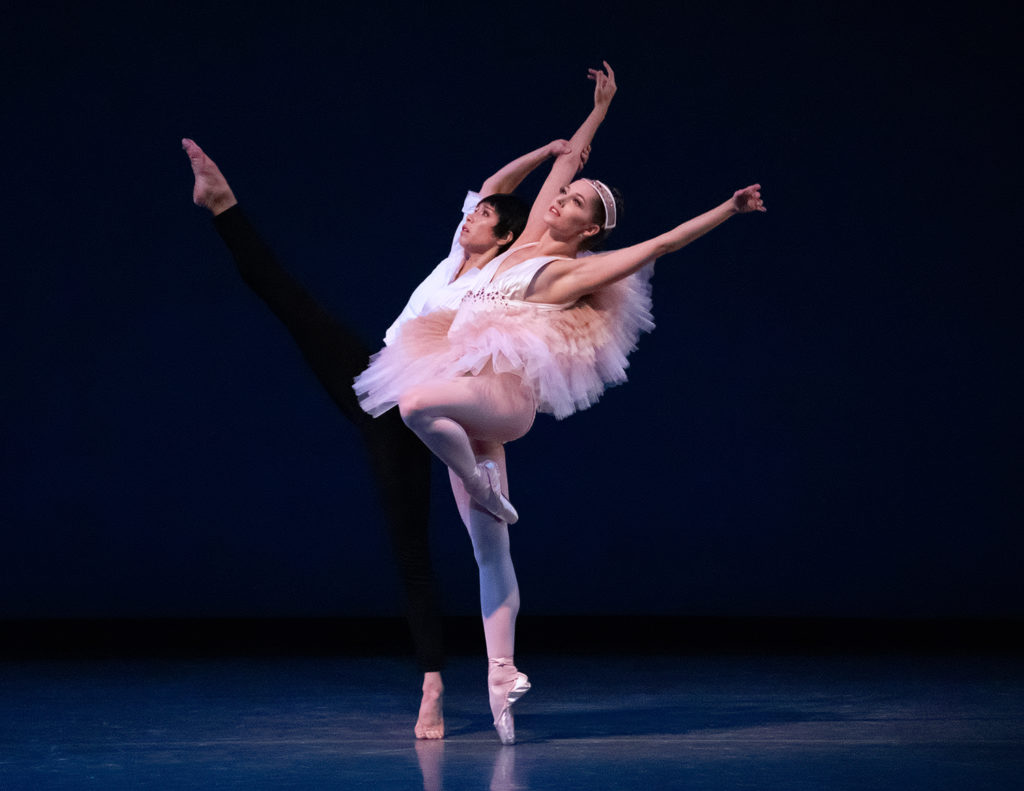
Georgina Pazcoguin, left, and Unity Phelan in Lauren Lovette’s THE SHADED LINE (World Premiere) (Photo: Erin Baiano)
Was Pazcoguin a stand-in for the choreographer, or an iconoclast taking on the patriarchy? Either way, she had a thrillingly contentious relationship with the ensemble, whose movement qualities changed in response to her feisty, tortured movements. The men at one point snapped to a tightly closed classical fifth position of the feet, their upper bodies melting into elegant but decidedly unclassical shapes. Toward the end, the ensemble arranged themselves in a traditional U-shape around Pazcoguin to strike a series of modernist poses triggered by repeated thunderings of the bass drum.
In one of several witty scenes, Pazcoguin was run over by a posse of swans. Once she struggled to her feet, she bumped into McKinnon, a sort of swan princess, who appeared to be throwing a tantrum. She was accompanied by four cygnets. This riff on the lakeside scene in Swan Lake, in which Prince Siegfried first stumbles across the enchanted swans, was a hoot.
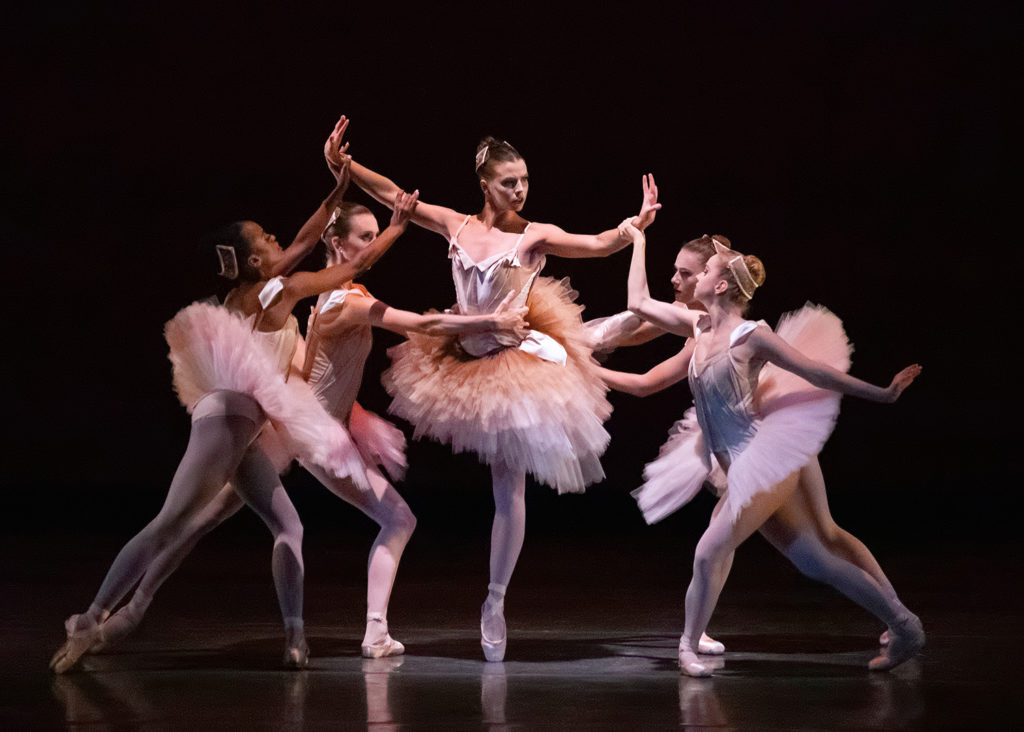
Mary Thomas MacKinnon, center, and company in Lauren Lovette’s THE SHADED LINE (World Premiere) (Photo: Erin Baiano)
Balanchine’s Symphony in C (Le Palais de Cristal) was a clever programming riposte to the new works, all surface glitter in its visualization of the joyful Bizet score. It dates back to 1947 but doesn’t look a day over 21, and remains a triumph of symmetry, clarity, and aerodynamics. Not even the high-lumen Swarovski crystals on the costumes – which were revamped by Marc Happel in 2012, their twinkling likely visible from outer space – could distract from the pleasure of watching Ashley Bouder luxuriate in her balances on pointe; the remote, divine Sterling Hyltin bend Amar Ramasar to her will; Indiana Woodward and Sebastian Villarini-Velez soar through space; and Brittany Pollack pummel the floor with her pointes and whirl at dizzying speed through the exhilarating fourth movement.

New York City Ballet wraps up George Balanchine’s SYMPHONY IN C (Photo: Erin Baiano)
Joseph Gordon partnered Bouder but seemed more concerned with flaunting his pirouettes than attending to her – no matter, for she could have handled the whole darn thing without him. Ramasar held his own admirably, without forgetting that his primary duty was to show up for Hyltin every time she decided she wanted to fly or plunge thrillingly toward the floor. All the men produced suitably springy sissonnes and the entire ensemble sizzled through that thrilling finale in which you keep thinking Bizet is winding down for the night – but then he revs up the orchestra with yet another dose of caffeine.
– Carla Escoda reviewed the Oct. 2, 2019, performance of New York City Ballet in Classic NYCB at Lincoln Center. –



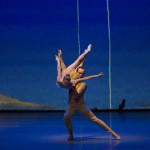
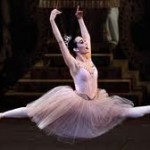
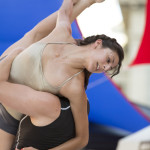

“The only metaphor I could come up with to explain the glittering gold skirts was capitalism.” – Ballet to the People, you are working too hard. And being too easy on these choreographers.
This was just another crap modern ballet. Maybe you liked the pretty music. The Lauren Lovette ballet was more interesting but the Gina Pazcoguin character was such a cliche. And what was up with the wig? When a choreographer slaps a wig on a dancer it usually means they’ve run out of interesting dance steps. Doesn’t it say something that a George Balanchine ballet from 1947 looks more modern than any of this stuff?
We’ve suffered through enough of these SJP galas featuring her favorite fashion designers of the moment and the same tiny group of “up and coming” choreographers who have been up and coming for years and NOT ONE DECENT BALLET HAS COME OUT OF THEM. And the poor dancers have to wear clothes that are a pain in the ass to move in because none of these designers know how to design for dance.
Yes I know they raise $2 million at these galas but how much do they spend? And after all these years has no one whispered in SJP’s ear that maybe we need another gimmick because we’re not getting any good ballets out of it?
Meanwhile what about the dozens of talented choreographers and costume designers without big names who are hoping to get noticed by the likes of New York City Ballet. When do they get a shot?
JP, thanks for engaging with my review and for making some interesting points.
I disagree with you about the zero batting average of the fall season gala. Did you see Kyle Abraham’s piece from last season (costumes by Giles Deacon)? I thought that one was a hit and I don’t think I’m alone in that.
As to the choreographers and designers without big names I understand why the big companies might not want to take those risks. But why not commission 5-minute pieces from 24 unknown choreographers to fill up a gala evening? Statistically, that’s more likely to yield some hits while limiting the fallout from the bombs.
I don’t see why gala has to produce ballets that last. They are just for show for one night. Everything about a gala is for showing off, for the people who pay a lot of money to show off their jewels, for the choreographers to try something new, for the fashion designers who certainly love to design for the most attractive bodies- the dancers bodies who can display their clothes better than the high-priced runway models. If the gala were to be repeated, that would lower its value. Scarcity is what makes something desirable, what drives up the price.
Dances are disposable, very unstable creations. On one night a dance can look great, on another night with another cast, with another group of musicians or a recording, or on a different stage, in front of a different audience, it could be very disappointing. Look at the difference between the reactions to the Frankenstein ballet in London and San Francisco: it was essentially the same ballet but mostly people in one city hated it and mostly people in the other city loved it.
I believe most of the choreographies ever made disappear quickly and are forgotten. That is natural because they are made on human bodies, not paintings on canvas, they were meant not to last.
Echoes of Merce Cunningham, Elena, in your concept of disposable dance-making. If there was a lot more money in the world of dance I think it would matter less if new work didn’t survive past a single showing.
There are a tiny handful of choreographic workshops that allow choreographers to play around in the studio without requiring them to produce a finished work for public consumption. There needs to be more funding for that kind of effort. But hard to convince donors that that kind of thing is worthwhile.